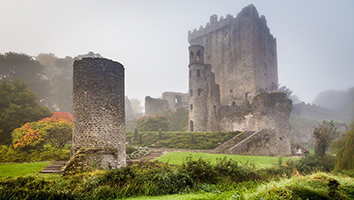https://ireland-calling.com/irish-names-oconnell/
https://www.johngrenham.com/surnamescode
https://www.libraryireland.com/Pedigrees1/OConnellHeber.php
The O’Conaill name, translates as “friendship,” or ‘strong as a wolf’ and is one of the twenty-five (25) most common in Ireland. O’Connell is the Anglicized version of the name. In Ulster it may also have derived from MacConn, an Anglicised form of the rare Mac Mhiolchon, ‘son of the hound-like one’.
Three distinct O’Connell clans arose separately as surnames in Connacht, Ulster and Munster, but the most prominent and numerous of these were the O’Connells of Munster. They were mainly located in County Kerry where they were originally lords of the barony of Magunihy from very ancient times.
Today a large majority of the O’Connells in Ireland are still to be found in Kerry, as well as in adjoining County Cork, but descendants with this name can be found in every county in Ireland.
The family arms is a stag trippant between three trefoils counter-charged. The crest is a stag’s head erased, charged with a trefoil. The motto in Gaelic is Cial agus neart, which means “Wisdom and Strength”.
In early mediaeval times, there were several unrelated septs of O’Connell; those of Ulster and Connact are seldom heard of even as late as the fourteenth century. O’Dugan (d. 1372) in the “Topographical Poems” mentions O’Conaill as a family of Oirghiall and another, again, as of Ui Maine. The name does not appear in the Four Masters after 1117 when the death of Cathasach O’Conaill, “noble Bishop of Connacht,” is recorded. Another of the name, Bishop of Thomond (Killaloe) is mentioned in the “Annals of Innisfallen” under date 927 A.D.; but if this be a true surname it is one of the earlier examples. The “Annals of Connacht” have no reference to the name.
Conaill Gabhra “Conaill of the Swift Horses”, was the king of Munster in 355 A.D. Conaill was in the line of Daire Caerb.
Daire Caerb was brother to Lughaidh – No. 88 in the line of Heber, the son of King Milisieus – and son of Oilioll Flann-beag. Daire Caerb had five sons including Fiacha and Fiachra – the ancestors to the O’Donovan family.
Fiacha had two sons Brian and Caibre – ancestors to the Ua Cairbre or O’Carberry.
Brian had a son Daire, and Daire had a son Fionnliath.
Fionnliath had a son Conaill and Conall son Ua Conaill or Connell.
The descendants of Conaill inhabited Upper and Lower Conello in County Tiperrary. In 1178, the O’Connells as well as the Harrington, Collins, and O’Donovan clans were expelled from Conello, County Limerick by Donald Mor O’Brien of Thomond. These families migrated south to County Kerry and Cork.
The O’Connells possessed the lordship of Magh o goinin, or the Barony of Magunihy, in East Kerry. The chief of the clan resided in Aghadoe. According to legend, “The O’Connell’s of slender swords, dwelt in the bushy forts betwixt the Laune and the Maine.” The earliest known chief of the O’Connell clan was Aodh (Hugh) O’Connell living in 1337. He had two children Aodh (Hugh) and Shela who were living in 1341.
Aodh, the son of the first chief, married Margaret O’Brien daughter of Mahon Moenmoy O’Brien, prince of Thomond.
Shela married John O’Mahony Mergagh, of Desmond.
Hugh and Margaret had a son Geoffrey, living in 1393, who married Catherine O’Connor-Kerry. They had a son Donal (Daniel) FitzGeofferey O’Connell, living in 1421, who married Honoria O’Sullivan-Beare.
During the Norman invasion, the FitzGerald family pressured by the powerful O’Donoghue family towards the Atlantic coast thereby displacing the O’Connells farther west. Their retreat led them to the peninsula of Iveragh, where the O’Connells became hereditary castellans of Ballycarbery under the MacCarthy Mor chiefs. The lineage continued with Sir Aodh (Hugh), living in 1436, son of Donal and Honoria O’Connell.
He married Mary Mc Carthy-Mor daughter of Donal Mc Carthy-Mor. Hugh was knighted by Sir Richard Nugent, Lord Deputy of Ireland.
They had a son Maurice who married Juliana O’Sullivan-Mor daughter of Rory O’Sullivan-Mor.
They had a son Morgan who married Elisabeth O’Donovan daughter of the chief of clan Cathail in Carberry.
They had a son Hugh who married Mora daughter of Sir Tadg O’Brien of Baille-na-Carriga, County, Clare.
They had a son Morgan of Ballycarbery who was named the High Sheriff of Kerry.
Morgan married Helena daughter of Donal Mc Carthy.
They had a son Richard who married Johanna daughter of Ceallaghan Mc Carthy. Richard surrendered the castle in Ballycarbery to the English.
Richard and Johanna had a son Maurice. Maurice, who also was named High Sheriff of Kerry, married Margaret O’Callaghan daughter of Conchobhar (Conor) O’Callaghan. They had two sons Richard who became the Bishop of Ardfert, and Geoffrey, who carried the title High Sheriff of Kerry. Geoffrey, who died on 25 April 1639, married Honoria daughter of “The Mc Crohan” Lettercastle.
Geoffrey and Honora had five sons Maurice of Caherbarnagh near Waterville, Daniel Mac Geoffrey of Ahavore, Peter of Claghanmacquin, John of Ashtown, and Charles of Ballymacleragh.
It seems there is not an active clan organisation for your name, at this time.
However, the revival of interest in Irish culture and heritage over the past 100 years has led to the revival of many Irish Clans. In more recent times, increased access to historical archives online, DNA testing and ease of travel to Ireland has led many individuals to explore their own genealogy and connections to Irish Clans. Some of these have gone on to establish Clan Associations in Ireland, the USA, the UK, Canada, Australia, New Zealand and anywhere that the Irish Diaspora has found itself.
Clans of Ireland Ltd invite those interested in Irish Clans to contact them with a view to explore the possibility of reviving your Irish Clan.

